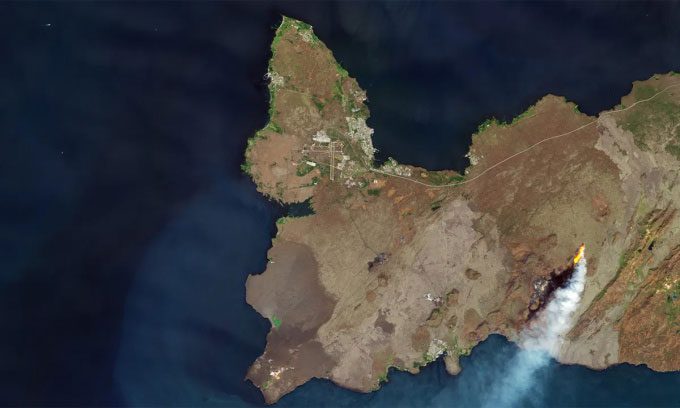Forming in southwestern Iceland, a newly emerged volcano crater rises over 30 meters and continues to develop.
On July 10, three cracks appeared at the base of a mountain in Iceland, spewing lava and gas into the atmosphere. Two of the cracks sealed up overnight, with lava now only flowing from a single volcanic cone (a triangular hill formed by material accumulating around a vent during eruptions). It has developed into a crater, now standing over 30 meters tall, and has become the latest volcano on Earth, IFL Science reported on July 28.

Copernicus Sentinel-2 satellite captures lava and smoke plume on July 11. (Photo: ESA).
Impressive images of the lava flow have been shared on social media since the cracks appeared. RÚV, the National Broadcasting Service of Iceland, is also sharing live videos on its YouTube channel so that people can continuously monitor the new volcano.
Litli-Hrútur, where the new volcano has formed, is part of the Fagradalsfjall volcanic region. Fagradalsfjall had been quiet for 800 years but began erupting again in March 2021 and once more in August 2022. The latest eruption occurred following thousands of earthquakes in the days leading up to it.
The news outlet Iceland Monitor reported on July 25 that the lava flow at Litli-Hrútur has now surpassed last August’s flow, reaching a volume of 12.4 million cubic meters. The European Space Agency (ESA) also released images captured by the Copernicus Sentinel-2 satellite showing lava and smoke plumes about a day after the eruption.
Litli-Hrútur is located approximately 30 kilometers southwest of Iceland’s capital, Reykjavik. The accumulation of toxic gases following the eruption has led authorities to impose access restrictions to the area. The fast-flowing lava on the first night caused fires in the surrounding dry land. Firefighters have managed to control the situation, and as of July 17, the area has been opened to tourists.
In 2021, when Litli-Hrútur erupted, new cracks appeared a few weeks later. Therefore, experts are closely monitoring the area. In a statement, the Icelandic Meteorological Office warned tourists about the dangers and unpredictable nature of the lava flow.
Experts say it is difficult to predict how long the eruption will last and that the crater is still developing. “There is a limit to the height that the crater can reach before it becomes unstable. Therefore, I think if the activity remains high, it is likely that we will witness subsequent events, where many parts of the crater rim may collapse,” stated Laura Wainman, a researcher at the School of Environment and Earth at the University of Leeds.


















































